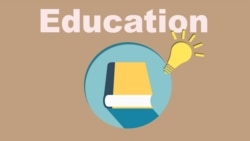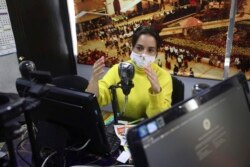At a small farmhouse not far from Colombia’s capital, Bogota, Marlene Beltran sits at a small table and turns on the radio to help her little brother with school work.
The five-year-old is learning how to draw on paper cubes to tell a story. There is no internet at the farm. The hour-long radio program keeps them busy while schools remain closed under COVID-19 measures.
At one time, radio was widely used in Latin America to teach basic math and reading skills. Now, such programs are expanding again to serve the public during lockdown.
The radio and television programs are especially popular in rural areas.
“We don’t want children to lose their studying habits,” said Diana Lopez, a teacher in the town of Funza. She helps produce a daily radio show for elementary school students. The area on the edge of Bogota has 10,000 public school students. About a third of them have no computers or internet at home.
“The radio lessons give children a space to develop their reading and writing skills and also show them that their teachers are still with them,” Lopez said.
In the United States and Europe, students mostly watch lessons on computers and use video conferencing. But in Latin America, officials were forced to find other solutions for stay-at-home students. Most education ministries have developed online learning for students with internet access. But many are also using traditional broadcast to reach poorer communities.
In Haiti, only a third of the population has internet access. So the government broadcasts educational programs on a state-run radio station.
Students from poor communities in Ecuador’s cities are watching television shows that provide them with school work. They can then drop completed work at schools for teachers to examine, correct, score and more.
Home internet connections are almost nonexistent in Cuba. State television broadcasts hours of educational content on different subjects and levels every day.
In Chile, educational organization Teach for All has developed a 30-minute daily podcast that is carried on more than 200 radio stations. To make the programs, teachers record themselves on their phones presenting the learning material. Producers mix in music and other effects. The programs cover science, math, history and writing.
Tomas Recart is the director of Enseña Chile, the Teach for All partner backing the radio programs. He said, “We have children in difficult situations and we want to motivate them and light up their hearts.”
A study this year by the Interamerican Development Bank says less than 35 percent of students in Colombia, Mexico and Peru have internet access. In rural Brazil, state governments provide internet service credit so that children can reach online learning sites over wireless phones.
Sabine Rieble-Aubourg is an education specialist at the Bank. She said, “Some countries have been looking for whatever content is available and for free” to broadcast. “As things get back to normal, they will have to organize content better, “ she said, to make sure the content is separated by educational level and meets with national education plans.
Until that happens, the energetic teachers are coming up with solutions to reach their students.
Deep in the Brazilian Amazon, elementary school teacher Andreza Nascimento records videos for her young students. “Some days they might not have internet,” said Nascimento, who sends her videos via WhatsApp. “But kids like technology, and I try to make the videos fun.”
Amparo Ramos is a preschool teacher in Funza, Colombia. Ramos says she has used her own money to print her lessons on paper for families without internet. She also uses WhatsApp to send lessons and educational games, similar to those she would use at school.
Ramos said the new process is very tiring, but she added, “We are behind in technology, so we need to come up with [new] ways to reach parents and their kids.”
I’m Caty Weaver.
The Associated Press reported this story. Hai Do adapted it for VOA Learning English. Caty Weaver was the editor.
____________________________________________________________
Words in This Story
cube -n. an object that has six square sides
habit -n. a usual way of behaving: something that a person does often in a regular and repeated way
motivate -v. to give (someone) a reason for doing something
content -n. to give (someone) a reason for doing something
elementary -adj. a school including usually the first four to the first eight grades and often a kindergarten
kid -n. a child










